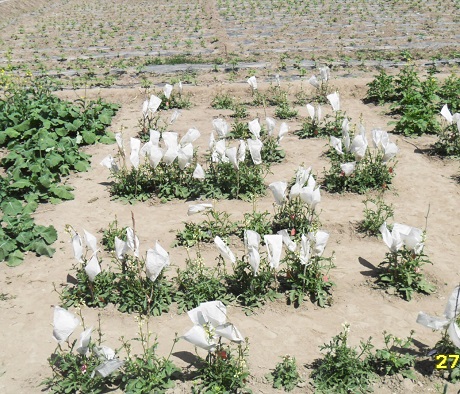

Preliminary Studies on the Variation in Self-compatibility among 52 Cultivars of Eruca sativa
? These authors contributed equally to this paper
Received date: 2014-06-23
Accepted date: 2014-12-26
Online published: 2015-10-09
To evaluate the genetic variation in self-compatibility in different cultivars of Eruca sativa (“rocket salad”), we used three methods of pollination bagging-self-pollination, bud-pollination and open-pollination―in field conditions and calculated the self-compatibility index and relative compatibility index of 52 cultivars of E. sativa from China, Iran and Pakistan. Results showed that (1) E. sativa is a highly self-incompatible plant, but several cultivars may have self-compatibility genes; (2) E. sativa cultivars show variation in self-compatibility; the mean compatibility index ranged from 0 to 4.98, with variation among individual plants; (3) E. sativa cultivars could be divided into 4 groups: highly self-compatible, self-compatible, self-incompatible and highly self-incompatible; and (4) the self-compatibility varied by geographical origin in the order of southwest>northwest>North China.

Wancang Sun , Xuelian Huang , Huiling Fan , Fangfang Luo , Xiaosha Xu . Preliminary Studies on the Variation in Self-compatibility among 52 Cultivars of Eruca sativa [J]. Chinese Bulletin of Botany, 2015 , 50(5) : 598 -604 . DOI: 10.11983/CBB14113
| 1 | 范惠玲, 孙万仓, 武军艳, 朱惠霞, 燕妮 (2007). 白芥自交亲和性分析. 西北植物学报 27, 938-942. |
| 2 | 方智远, 孙培田, 刘玉梅 (1983). 甘蓝杂种优势利用和自交不亲和系选育的几个问题. 中国农业科学 16(3), 51-62. |
| 3 | 刘后利 (2000). 油菜遗传育种学. 北京: 中国农业大学出版社. pp. 82-177. |
| 4 | 孙万仓 (2000). 中国芸芥的分布、类型划分及油菜-芸芥杂交亲和性研究. 博士论文. 长沙: 湖南农业大学. pp. 26-30. |
| 5 | 孙万仓, 范惠玲, 叶剑, 张亚宏, 刘雅利, 曾军, 王鹏 (2006). 白菜型油菜自交亲和性变异分析. 西北植物学报 26, 688-695. |
| 6 | 孙万仓, 官春云, 孟亚雄, 刘自刚, 张涛, 李栒, 杨随庄, 令利军, 陈社元, 曾秀存, 王鹤龄 (2005). 芸芥(Eruca sativa Mill.)与芸薹(Brassica L.)属3个油用种的远缘杂交. 作物学报 31, 36-42. |
| 7 | 陶国华, 徐家炳, 李银安 (1982). 关于大白菜自交不亲和性稳定性问题的探讨. 中国农业科学 15(2), 30-37. |
| 8 | 张涛, 孙万仓 (2004). 芸芥与白菜型油菜远缘杂交亲和性研究. 西北农业学报 13(2), 28-30. |
| 9 | Bell DJ, Rowland LJ, Stommel J, Drummond FA (2010). Yield variation among clones of lowbush blueberry as a function of genetic similarity and self-compatibility.J Am Soc Hortic Sci 135, 259-270. |
| 10 | Busch JW, Urban L (2011). Insights gained from 50 years of studying the evolution of self-compatibility in Leavenworthia (Brassicaceae).Evol Biol 38, 15-27. |
| 11 | Chen K, Zhang XB, Jiang JL, Wang XY (2011). Plantlet regeneration from cotyledon, cotyledon petiole, and hypocotyl explants via somatic embryogenesis pathway in roquette (Eruca sativa Mill.).Plant Biosyst 145, 68-76. |
| 12 | Kodad O, Socias i Company R (2008). Fruit set evaluation for self-compatibility selection in almond.Sci Hortic 118, 260-265. |
| 13 | Matsuzawa Y, Mekiyanon S, Kaneko Y, Bang SW, Wakui K, Takahata Y (1999). Male sterility in alloplasmic Brassica rapa L. carrying Eruca sativa cytoplasm.Plant Breed 118, 82-84. |
| 14 | Omirou M, Papastefanou C, Katsarou D, Papastylianou I, Passam HC, Ehaliotis C, Papadopoulou KK (2012). Relationships between nitrogen, dry matter accumulation and glucosinolates in Eruca sativa Mill. The applicability of the critical NO3-N levels approach.Plant Soil 354, 347-358. |
| 15 | Seavey SR, Bawa KS (1986). Late-acting self-incompa- tibility in angiosperms.Bot Rev 52, 195-219. |
| 16 | Sun WC, Pan QY, Liu ZG, Meng YX, Zhang T, Wang HL (2005). Overcoming self-incompatibility in Eruca sativa by chemical treatment of stigmas.Plant Genetic Resources 3, 13-18. |
| 17 | Tel-Zur N, Dudai M, Raveh E, Mizrahi Y (2012). Selection of interspecific vine cacti hybrids (Hylocereus spp.) for self-compatibility.Plant Breed 131, 681-685. |
| 18 | ——————————————— |
/
| 〈 |
|
〉 |